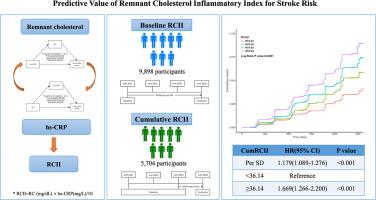Predictive value of remnant cholesterol inflammatory index for stroke risk: Evidence from the China health and Retirement Longitudinal study
IF 13
1区 综合性期刊
Q1 MULTIDISCIPLINARY SCIENCES
引用次数: 0
Abstract
Introduction
Remnant cholesterol (RC) and high-sensitivity C-reactive protein (hs-CRP) are established stroke risk factors, but their joint impact remains unclear.
Objectives
This study aimed to evaluate the predictive value of the remnant cholesterol inflammatory index (RCII), a novel index integrating RC and hs-CRP, in assessing stroke risk.
Methods
We analyzed 9,898 participants aged 45 years or older, with no history of stroke at baseline, from the China Health and Retirement Longitudinal Study (CHARLS). RCII was calculated using the formula: RCII = RC (mg/dL) × hs-CRP(mg/L)/10. A subset of 5,704 participants was studied to investigate the relationship between cumulative RCII exposure and stroke incidence. The associations of both baseline and cumulative RCII with stroke risk were assessed using Cox proportional hazards regression model.
Results
During a median 7-year follow-up, 560 participants (5.7 %) experienced an incident stroke. Stroke incidence escalated with increasing RCII quartiles, from 3.5 % (Q1) to 7.6 % (Q4). In multivariable-adjusted analyses, each standard deviation increase in RCII was significantly associated with a 10.6 % increased risk of stroke (HR = 1.106, 95 % CI: 1.048–1.167). ROC analysis revealed that RCII had the highest AUC at 0.581, higher than RC (0.566) and hs-CRP (0.560), though the difference with RC was not statistically significant (P = 0.166). Mediation analysis indicated a reciprocal mediation between RC and hs-CRP on stroke risk. In a 3-year subset analysis, 288 participants suffered a stroke. Participants with cumulative RCII levels exceeding 36.14 had a significantly increased risk of incident stroke (HR = 1.462, 95 % CI: 1.102–1.939). Subgroup analyses showed a significant positive association between elevated RCII levels and stroke risk in males, but not in females.
Conclusions
Elevated levels of RCII, both at baseline and cumulative, are significantly associated with an increased risk of stroke. Early intervention in patients with high RCII may further help reduce stroke risk.


残余胆固醇炎症指数对脑卒中风险的预测价值:来自中国健康与退休纵向研究的证据
导言残余胆固醇(RC)和高敏 C 反应蛋白(hs-CRP)是公认的脑卒中风险因素,但它们的联合影响仍不明确。本研究旨在评估残余胆固醇炎症指数(RCII)在评估脑卒中风险中的预测价值,RCII 是一种整合了 RC 和 hs-CRP 的新型指数。方法我们分析了中国健康与退休纵向研究(CHARLS)中 9898 名 45 岁及以上、基线无脑卒中病史的参与者。RCII 的计算公式为RCII = RC (mg/dL) × hs-CRP(mg/L)/10。对 5704 名参与者进行了研究,以调查累积 RCII 暴露与脑卒中发病率之间的关系。结果在中位 7 年的随访中,560 名参与者(5.7%)发生了中风。中风发病率随着 RCII 四分位数的增加而上升,从 3.5% (Q1) 到 7.6% (Q4)。在多变量调整分析中,RCII 每增加一个标准差,中风风险就会增加 10.6%(HR = 1.106,95 % CI:1.048-1.167)。ROC 分析显示,RCII 的 AUC 最高,为 0.581,高于 RC(0.566)和 hs-CRP(0.560),但与 RC 的差异无统计学意义(P = 0.166)。中介分析表明,RC 和 hs-CRP 对中风风险具有互为中介的作用。在一项为期 3 年的子集分析中,288 名参与者发生了中风。累计 RCII 水平超过 36.14 的参与者发生中风的风险显著增加(HR = 1.462,95 % CI:1.102-1.939)。亚组分析显示,男性 RCII 水平升高与中风风险呈显著正相关,而女性则不然。对高 RCII 患者进行早期干预可能有助于进一步降低中风风险。
本文章由计算机程序翻译,如有差异,请以英文原文为准。
求助全文
约1分钟内获得全文
求助全文
来源期刊

Journal of Advanced Research
Multidisciplinary-Multidisciplinary
CiteScore
21.60
自引率
0.90%
发文量
280
审稿时长
12 weeks
期刊介绍:
Journal of Advanced Research (J. Adv. Res.) is an applied/natural sciences, peer-reviewed journal that focuses on interdisciplinary research. The journal aims to contribute to applied research and knowledge worldwide through the publication of original and high-quality research articles in the fields of Medicine, Pharmaceutical Sciences, Dentistry, Physical Therapy, Veterinary Medicine, and Basic and Biological Sciences.
The following abstracting and indexing services cover the Journal of Advanced Research: PubMed/Medline, Essential Science Indicators, Web of Science, Scopus, PubMed Central, PubMed, Science Citation Index Expanded, Directory of Open Access Journals (DOAJ), and INSPEC.
 求助内容:
求助内容: 应助结果提醒方式:
应助结果提醒方式:


